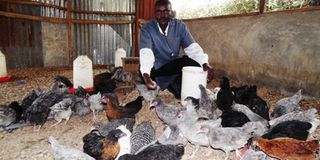Hatching kienyeji chicks fetches me more than eggs

Richard Rono attends to his kienyeji chicks in Bomet. PHOTO | ANDREW MIBEI |
What you need to know:
- The hens supply Rono with eggs for the incubators and he sells the surplus at Sh20 each.
- At two months, the birds go for Sh250 and at three Sh350.
Some hens cluck as they run around the compound and others browse the ground for food.
The cocks, on the other hand, crow intermittently just to assure the rest of the brood that everything is under control.
This is Richard Rono’s home in Kapchekoro village, Bomet County, where the farmer keeps chicken.
However, unlike many farmers who keep the birds for eggs or meat, Rono mainly hatches chicks for sale.
“I started with exotic chicken and I was keeping them for eggs but after realising that the market was saturated, I went for Kienyeji birds and started hatching chicks because there is less competition,” says Rono, who constructed a semi-permanent house worth Sh150,000 for his chicken.
At any time, the farmer keeps an average of 100 hens and 15 cocks in a recommended ratio of one cock for every seven hens. He hatches up to 450 chicks per month.
The hens supply him with eggs for the incubators and he sells the surplus at Sh20 each.
The farmer has two incubators. A manual one with a capacity of 360 eggs that he bought five years ago at Sh50,000 and an automatic one with a capacity of 480 eggs that he acquired three years ago at Sh140,000.
“It takes me 10 days to get enough eggs for the two incubators. When the eggs are hatching, I sell the surplus which earn me about Sh20,000 per month after deducting the cost of feeds.”
The eggs hatch after 21 days. “I, thereafter, transfer the chicks from the incubator to a pen equipped with a charcoal brooder. They will stay there for a month,” explains Rono, who spends up to Sh3,000 per month on charcoal.
“The chicks need to be kept warm, that is why I use the charcoal burner. It burns throughout the night and sometimes during the day.”
VACCINES ARE CRUCIAL
He offers the chicks commercial feeds, starting with chick mash, which goes for between Sh2,500 and Sh3,000 for a 50kg bag. Clean water and vaccines are also crucial for the chicks’ survival.
“If one misses to vaccinate the chicks against Gumboro and Newcastle Disease, then their chances of survival would be minimal. I also vaccinate them against Fowl Typhoid as advised by agricultural extension officer,” says Rono, who also hatches eggs for other farmers at Sh1 per day for each. He makes up to Sh10,000 per month from this venture.
He sells the chicks to farmers from Bomet, Keroka and Kericho after about a month from Sh120 to Sh180.
“I do not sell the very young chicks to beginners because they may not manage them well. I usually advise them to pick those chicks that are over a month.”
If the chicks are not bought in the first month, Rono usually transfers them to another pen.
“I keep the birds in different pens according to their ages. One should not mix them to prevent spread of diseases and bullying. It is wrong to mix chicks, for instance, with older birds,” offers Rono, who supplements commercial feeds with wheat, sorghum, fresh grass and vegetables.
At two months, the birds go for Sh250 and at three Sh350. He allows the hens to forage in his compound each day after feeding on layers mash.
Bomet Central Livestock Production Officer Evans Kiplagat says farmers keeping Kienyeji chicken spend less on disease control because they are resistant to many poultry infections.
“Their adaptability to varied living conditions makes them suitable breeds for every farmer. The indigenous breeds do not entirely depend on commercial feeds and they can do well under free-range thus cutting the cost of production,” says Kiplagat, adding that they are preferred by many consumers because their meat is tastier.
He advises farmers to maximum their returns from poultry by diversifying.
“That egg a farmer sells at Sh15 or Sh20 can hatch in 21 days and he sells the chicks at Sh150. This is better than just selling eggs.”




